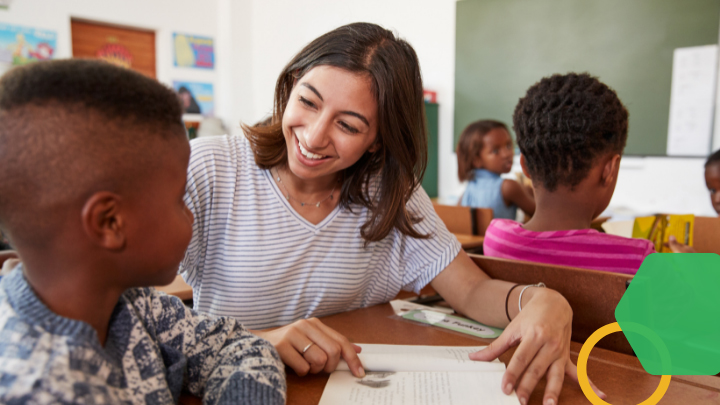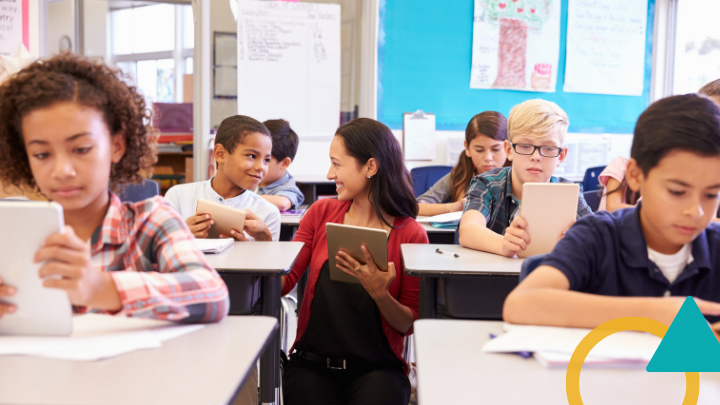The co-teaching model can transform the general education classroom into a more inclusive environment where students receive remediation, interventions, and individualized instruction. These practices matter now more than ever. The worry about lost time feels like a heavy weight as we enter the final months of the 2020-2021 school year, as interruptions to instruction have undoubtedly affected students academically, socially, and emotionally, as well as possibly widened disproportionate educational gaps. Two educators in the room (virtual or in-person) means more opportunities to build meaningful relationships with students, differentiate instruction, provide evidence-based interventions, and in more simple terms…meet students where they are.
How do we support our students’ needs now in the final months of this school year and prepare for the unknown gaps and challenges of the next school year? In this pivotal moment, how can we leverage the co-teaching model to address the diverse needs of our students?
Dr. Marilyn Friend and Dr. Lynne Cook first described the co-teaching model in their book, Interactions: Collaboration Skills for School Professionals, as “a specific service delivery option that is based on collaboration,” and they went on to describe six collaborative approaches which are described in BetterLesson’s Co-Teaching strategy. Of course, all the approaches are valuable, but given this moment in education, the following provides more flexible opportunities to address the urgent needs of students:
1. Parallel Teaching
Why does this matter?
Parallel teaching breaks the class in half, where both educators can provide instruction to a smaller group of students. Time with students is more limited than ever this year, making it even more difficult for teachers and students to create meaningful connections. Students are more likely to engage and take risks when they feel part of a community. In the virtual classroom, they are more likely to keep their cameras on and share their voices.
How can you accomplish this in-person/hybrid?
As well as build relationships with students, providing instruction in the parallel model assists teachers in collecting meaningful and immediate feedback so they can tailor their instruction to best fit the students in front of them. It’s much easier for a teacher to read the room when it’s half the size! Simple check-in strategies like Start, Stop, Continue Feedback Protocol and Quick Self-Assessment Checks with Learning Targets ask students to pause and check for understanding.
How can you accomplish this virtually?
Zoom’s co-hosting feature allows co-teachers to share the controls, creating parity in the remote setting. Fewer students means more meaningful monitoring of students’ responses whether it be via the chat feature, Go Guardian, or an assessment tool like Peardeck. Co-teachers can use the data they collect during these smaller sessions to plan for further strategic grouping.
Tech tip! If you are parallel teaching virtually, avoid teaching in the same room due to computer echo. If you’ve played the mute/unmute game with your co-teacher, then you get it! One option is for one of the teachers to go elsewhere, like an office. If you have some students in-person, consider assigning one teacher to the physical classroom, while the other teacher joins remotely from another room.
BetterLesson strategies to help with implementation:
2. Alternative Teaching and/or Strategic Grouping
Why does this matter?
Friend and Cook coined “alternative teaching”, but today it may be more commonly referred to as Strategic Grouping. This is when one teacher manages the whole group, while another teacher provides specialized instruction/interventions with a smaller group(s). Strategic grouping strategies empower teachers to differentiate their instruction to meet the diverse needs of their students.
How can you accomplish this in-person/hybrid?
The groups can be made by the teachers using students’ data or students can self-assess using a tool like Marzano’s Self-Assessment Rubric. With a co-teaching duo, two groups can be teacher-led, while another group may be student-led or individual. The key is to embrace the fact that students are on different levels and provide an avenue to help each student make progress. The groups should not be definitive; students should be able to move in and out of groups depending on their needs (i.e. direct instruction, individualized practice, or a challenge).
How can you accomplish this virtually?
In Zoom, teachers can create groups prior to class, during class, or allow students to self-select their groups (which pairs especially well the Marzano Self-Assessment strategy). A teacher and blogger from Virginia, Ester Park created and shared an example of a Google Meet breakout room strategy that provided students with the choice of the type of instruction they need. As these groupings are occurring, one teacher can pull individual students to conference or provide interventions.
BetterLesson strategies to help with implementation:
3. Station Teaching
Why does this matter?
Stations provide educators with a sustainable and intentional path to skill development and practice. Once it becomes a classroom norm, students can navigate the rotations with increasing independence, and each co-teacher can support given stations, allowing them to provide targeted interventions. This model often gets labeled “elementary”, but it is certainly a practical and beneficial model for the secondary classroom too. It provides co-teachers with the chance to collect data, target needs, and help students feel a sense of ownership and responsibility for their own learning.
How can you accomplish this in-person/hybrid?
When designing stations, it’s all about creating a sustainable practice for your class. Start small, and add stations as your students build their independence. This model naturally lends itself to a blended classroom design, where students can individually participate in online skill practice tools as well as hand-on analog tools in teacher-led small groups. When designing stations, the skill practice can stay the same and increase in complexity over time (e.g. in an ELA class, the stations may continually focus on reading skills like fluency, decoding, comprehension), or the skills can reflect the given unit and change with the curriculum (e.g. in a math class, the stations may directly reflect a graphing unit, then shift to an algebra unit).
How can you accomplish this virtually?
This can be done using Hyperdocs or a Google slide, especially when used with the add-on, Pear Deck or Nearpod. Grouping students via breakout rooms is always a great option. This also provides each co-teacher with the opportunity to meet one-on-one with students to provide individualized instruction.
BetterLesson strategy to help with implementation:
Final Thoughts
Typically, Friend and Cook’s “Team Teaching” is seen as the holy grail of co-teaching strategies, and while it’s crucial for co-teaching teams to collaborate, whole group teaching approaches should be used thoughtfully and minimally at this moment. Given the current instructional and emotional needs of students, providing more small group and individualized attention is important.
The best gift of co-teaching is the daily relationship and support of a colleague. No matter the co-teaching approaches you and your partner decide to use, take care of each other. The last year has brought about challenges that we never imagined; keep reminding each other that the work you do daily matters.







